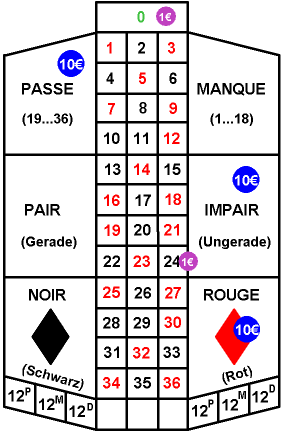Difference between revisions of "Aufgaben:Exercise 1.3Z: Winning with Roulette?"
| Line 11: | Line 11: | ||
*If a player bets on a group of numbers with three fields (in the example, the 1-euro chip for the numbers from "22" to "24"), he would receive $ 11$ times his stake as winnings in addition to his bet. | *If a player bets on a group of numbers with three fields (in the example, the 1-euro chip for the numbers from "22" to "24"), he would receive $ 11$ times his stake as winnings in addition to his bet. | ||
| − | *If a player bets on a group of numbers with $ 18$ fields (for example, the 10-euro chips on " | + | *If a player bets on a group of numbers with $ 18$ fields (for example, the 10-euro chips on "Rouge", on "Impair" and on "Passe"), he will receive the same amount back as winnings in addition to his bet. |
*If the number drawn does not belong to one of the squares he occupies, his bet is lost. | *If the number drawn does not belong to one of the squares he occupies, his bet is lost. | ||
| Line 31: | Line 31: | ||
<quiz display=simple> | <quiz display=simple> | ||
| − | { | + | {A player simultaneously places one 1-euro chip on each of the squares „0“, „Rot“ und „Schwarz“. Wie groß ist sein mittlerer Gewinn pro Spiel? |
|type="{}"} | |type="{}"} | ||
$G_1 \ =\ $ { -0.083--0.079 } $\ \rm Euro$ | $G_1 \ =\ $ { -0.083--0.079 } $\ \rm Euro$ | ||
Revision as of 22:52, 23 November 2021
In roulette, a winning number $Z$ is determined in each game by means of a ball and a roulette wheel, where we want to assume that all possible numbers $Z \in \{0, 1, 2, \ \text{...} \ , 36 \}$ are equally probable.
The players can now bet on a single number or on a group of numbers with chips of different value. Some of the possibilities and the corresponding winnings will be briefly explained here on the basis of the chips bet by a player (see graph):
- If a player bets on a number (in the example on "0"), he would get back $35$ times his stake as winnings.
- If a player bets on a group of numbers with three fields (in the example, the 1-euro chip for the numbers from "22" to "24"), he would receive $ 11$ times his stake as winnings in addition to his bet.
- If a player bets on a group of numbers with $ 18$ fields (for example, the 10-euro chips on "Rouge", on "Impair" and on "Passe"), he will receive the same amount back as winnings in addition to his bet.
- If the number drawn does not belong to one of the squares he occupies, his bet is lost.
Hints:
- The exercise belongs to the chapter Set Theory Basics.
- Enter any losses as negative winnings in the following questions.
- The topic of this chapter is illustrated with examples in the (German language) learning video Mengentheoretische Begriffe und Gesetzmäßigkeiten $\Rightarrow$ Set Theoretical Concepts and Laws.
Questions
Musterlösung
- Er gewinnt $33$ Euro, wenn tatsächlich die $0$ getroffen wird. Daraus folgt:
- $$G_1 =\rm {36}/{37}\cdot (-1\hspace{0.1cm} Euro) + {1}/{37}\cdot (33\hspace{0.1cm} Euro) \hspace{0.15cm}\underline {= - 0.081\hspace{0.1cm} Euro\hspace{0.1cm}(Verlust)}.$$
(2) Der Spieler gewinnt und verliert nichts, wenn nicht die Null gezogen wird. Erscheint die Null, so verliert er seinen Einsatz:
- $$G_2 = \rm {1}/{37}\cdot (-2\hspace{0.1cm} Euro)\hspace{0.15cm}\underline { = -0.054 \hspace{0.1cm}Euro \hspace{0.1cm}(Verlust)}.$$
(3) Kommt "Rot", so gewinnt er neun Euro.
- Kommt die Null, gewinnt er effektiv $25$ Euro.
- Wird "Schwarz" gezogen, so verliert er seinen gesamten Einsatz von $11$ Euro:
- $$G_3 = \rm {18}/{37}\cdot (10 -1) + {1}/{37}\cdot (35-10) + {18}/{37}\cdot (-10-1)\hspace{0.15cm}\underline { = - 0.297\hspace{0.1cm}Euro}.$$
(4) Den höchsten Gewinn erzielt er bei $Z_{\rm Wunsch} \; \underline{ = 23} $. Dann gewinnen vier seiner fünf Chips:
- $$G_4 = \rm 10\hspace{0.1cm}(da\hspace{0.1cm} Rot ) + 10\hspace{0.1cm}(da\hspace{0.1cm} Passe) + 10\hspace{0.1cm}(da \hspace{0.1cm} Impair) + \rm 11\hspace{0.1cm}(da\hspace{0.1cm}zwischen \hspace{0.1cm}22\hspace{0.1cm} und \hspace{0.1cm}24) - 1 \hspace{0.1cm}(da \hspace{0.1cm}nicht \hspace{0.1cm}0) \hspace{0.15cm}\underline {= 40 \hspace{0.1cm}Euro}.$$
- Kommt dagegen die Null, so gewinnt er lediglich $\rm 35 - 31 = 4 \ Euro$.
(5) Nein, leider nicht. Im statistischen Mittel gewinnt immer die Bank.
